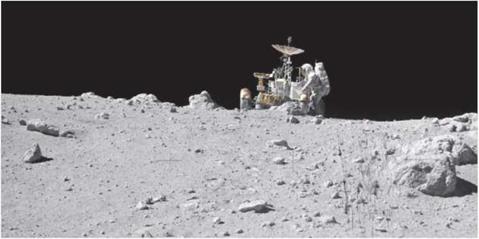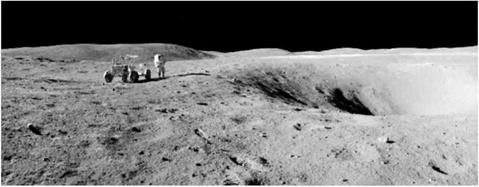NEW KNOWLEDGE: APOLLO 16
The scientific feast continued with Apollo 16, launched on 14 April 1972 to explore what were believed to be ‘highland volcanics’ within the rugged hills near the crater Descartes towards the centre of the Moon’s disk. Its crew of John Young, Charlie Duke and Ken Mattingly nearly had to abort their mission some hours before landing. When Mattingly tried to test the back up steering system of the main engine on board the CSM Casper preparatory to a scheduled burn, it began to wobble violently. Once this glitch had been overcome, Young and Duke made a successful landing six hours late in their LM Orion.
After a night’s sleep, they stepped onto the surface, immediately prepared their rover, and set up their ALSEP science station. Although Duke had no difficulty drilling into the surface for the heat-flow experiment, Young inadvertently disabled the instrument by tripping over its cable. Their first traverse was a short one to craters where they only found breccia or ‘instant rock’, made in the high-energy environment of an impact event when fragments were bound together by the melting of powdered rock. Their second and third days also concentrated on traverses, seeking signs of the expected volcanism but finding only beat-up rocks of a vast
|
Charlie Duke works at the lunar rover near North Ray Crater during Apollo 16. Contamination to the film acquired during the mission is visible to the right. (NASA) |
|
John Young and the lunar rover next to Plum Crater during Apollo 16. (Panorama by Erik van Meijgaarden from NASA images.) |
ejecta blanket. In orbit, Mattingly continued the same type of observations that Apollo 15 had made, but over a largely different swathe of terrain.
The surface crew returned to the CSM and then, in view of the problem with their engine’s steering, departed lunar orbit a day early. Apart from being unable to release their subsatellite into the correct orbit, this curtailment of the Apollo 16 flight barely impinged on the quantity and quality of its results.
It was an example of classic scientific research. A hypothesis had been proposed by geologists to explain the origin of light-toned plains that were visible across some areas of the lunar highlands. Part of Apollo 16’s brief was to test this hypothesis, and with samples and observations to hand, the theories were proved wrong. However, this is how scientific progress is made, because it prompted a new hypothesis and a better understanding of the Moon’s evolution as a planetary body.












